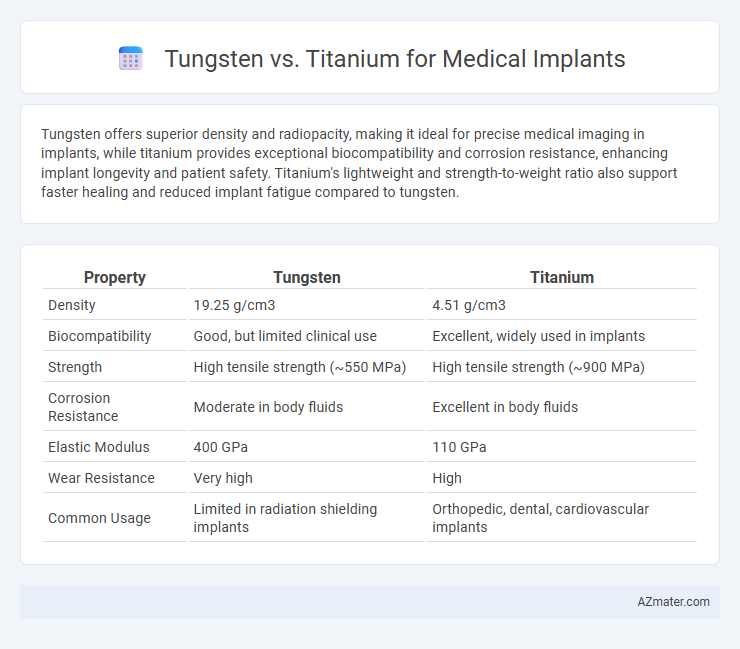Tungsten offers superior density and radiopacity, making it ideal for precise medical imaging in implants, while titanium provides exceptional biocompatibility and corrosion resistance, enhancing implant longevity and patient safety. Titanium's lightweight and strength-to-weight ratio also support faster healing and reduced implant fatigue compared to tungsten.
Table of Comparison
| Property | Tungsten | Titanium |
|---|---|---|
| Density | 19.25 g/cm3 | 4.51 g/cm3 |
| Biocompatibility | Good, but limited clinical use | Excellent, widely used in implants |
| Strength | High tensile strength (~550 MPa) | High tensile strength (~900 MPa) |
| Corrosion Resistance | Moderate in body fluids | Excellent in body fluids |
| Elastic Modulus | 400 GPa | 110 GPa |
| Wear Resistance | Very high | High |
| Common Usage | Limited in radiation shielding implants | Orthopedic, dental, cardiovascular implants |
Introduction to Tungsten and Titanium in Medical Implants
Tungsten and titanium are prominent materials in medical implants due to their unique mechanical and biocompatible properties. Tungsten offers exceptional density and strength, making it ideal for applications requiring high wear resistance and radiopacity in imaging. Titanium is widely favored for its excellent corrosion resistance, lightweight nature, and ability to osseointegrate, which enhances long-term implant stability and promotes bone growth.
Material Properties: Comparing Tungsten and Titanium
Tungsten exhibits exceptional hardness and a high melting point, making it highly durable for medical implants that require resistance to wear and deformation. Titanium offers superior biocompatibility, excellent corrosion resistance, and a lower density, resulting in lighter implants that promote better patient comfort. The choice between tungsten and titanium hinges on balancing the need for mechanical strength versus weight and biocompatibility in implant design.
Biocompatibility and Toxicity Profiles
Tungsten exhibits high density and strength but presents biocompatibility challenges due to potential cytotoxicity and inflammatory responses, limiting its use in medical implants. Titanium is widely favored in medical implant applications for its excellent biocompatibility, corrosion resistance, and minimal toxicity, promoting osseointegration and long-term implant stability. Current research supports titanium's superior safety profile and compatibility with human tissue compared to tungsten, making it the preferred choice for orthopedic and dental implants.
Corrosion Resistance in Medical Environments
Tungsten exhibits excellent corrosion resistance in medical environments due to its stable oxide layer, making it suitable for long-term implants exposed to bodily fluids. Titanium surpasses tungsten by forming a highly durable and biocompatible titanium dioxide layer that offers superior resistance to pitting and crevice corrosion in aggressive physiological conditions. The enhanced corrosion resistance of titanium, combined with its lightweight properties, makes it the preferred material for medical implants requiring reliability and longevity.
Mechanical Strength and Durability
Titanium exhibits exceptional mechanical strength combined with superior corrosion resistance, making it highly durable for medical implants in load-bearing applications. Tungsten offers higher density and hardness but lacks the flexibility and biocompatibility of titanium, which is crucial for implant longevity and patient safety. Titanium's ability to withstand cyclic stresses without degradation ensures reliable performance in orthopedic and dental implants.
Imaging Compatibility: MRI and X-ray Considerations
Tungsten exhibits high density and atomic number, causing significant artifacts in MRI and X-ray imaging, which can obscure diagnostic details near implants. Titanium, with its lower density and non-ferromagnetic properties, offers superior compatibility by minimizing image distortion and enhancing clarity during MRI and X-ray scans. Selecting titanium implants improves the accuracy of postoperative imaging assessments and reduces diagnostic challenges in medical applications.
Implant Design Flexibility and Customization
Tungsten offers exceptional density and radiopacity, improving imaging precision but limiting implant design flexibility due to its hardness and brittleness. Titanium provides superior biocompatibility and corrosion resistance with outstanding strength-to-weight ratio, enabling highly customizable and complex implant geometries for patient-specific applications. The flexibility of titanium alloys supports advanced manufacturing techniques like 3D printing, facilitating tailored implant designs that enhance integration and functionality.
Cost Analysis: Tungsten vs. Titanium
Tungsten is generally more expensive than titanium due to its higher raw material cost and challenging machining processes, impacting overall implant production expenses. Titanium offers a cost-effective alternative with favorable strength-to-weight ratio and corrosion resistance, reducing long-term maintenance costs in medical implants. Cost analysis must consider not only initial material prices but also manufacturing complexity and biocompatibility to determine the most economical choice for implant applications.
Clinical Applications and Case Studies
Tungsten and titanium are critical materials in medical implants due to their biocompatibility and mechanical properties, with titanium favored for its excellent corrosion resistance and osseointegration in orthopedic and dental implants. Clinical case studies show titanium implants demonstrate superior long-term success rates in joint replacements and bone fixation, while tungsten's high density and radiopacity make it valuable in radiation therapy shielding devices but less common in load-bearing implants. Titanium's integration with bone tissue reduces implant failure risk, whereas tungsten's brittleness limits its use to specialized clinical applications rather than widespread structural implant functions.
Future Trends in Medical Implant Materials
Future trends in medical implant materials emphasize the development of bio-compatible alloys with enhanced strength and corrosion resistance, where tungsten and titanium remain key contenders. Titanium's lightweight nature and excellent osseointegration properties continue to dominate orthopedic and dental implants, while tungsten's exceptional density and wear resistance offer promising applications in radiation shielding implants and joint replacements. Research is increasingly focused on combining tungsten and titanium to create composite materials that leverage the biocompatibility of titanium and the mechanical robustness of tungsten for next-generation implant designs.

Infographic: Tungsten vs Titanium for Medical Implant
 azmater.com
azmater.com